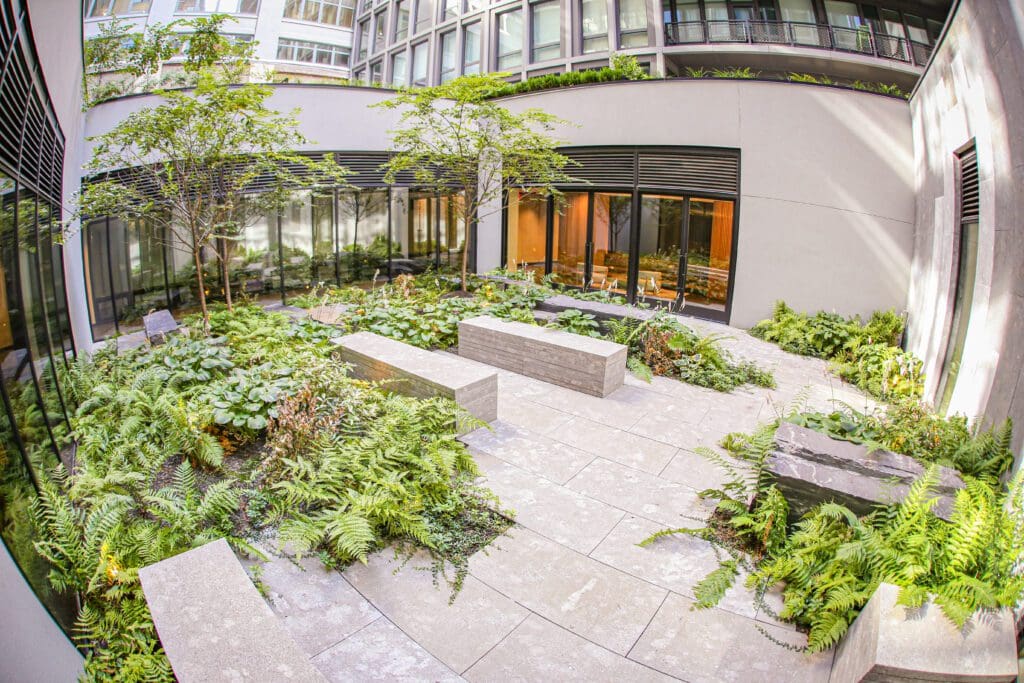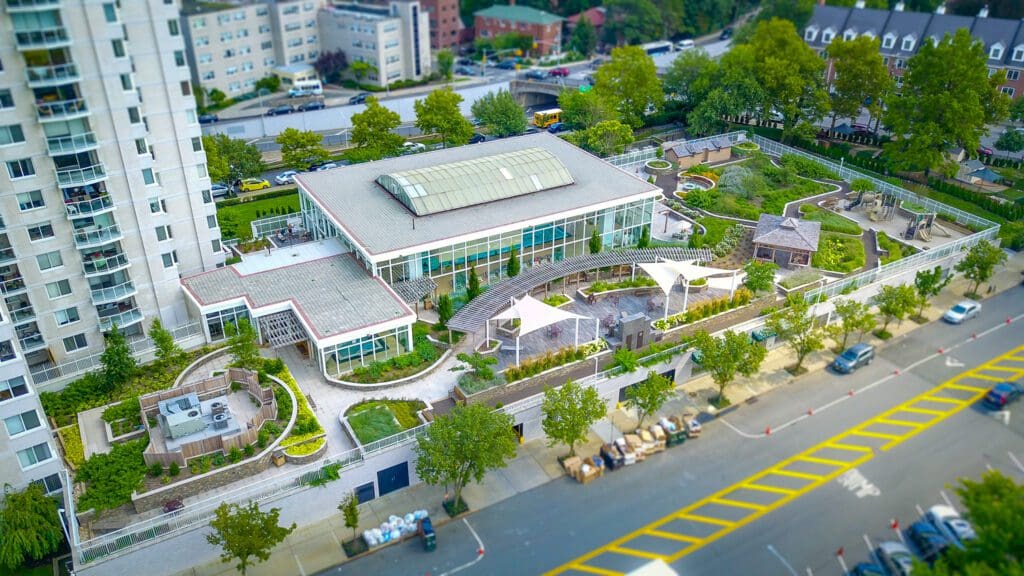Green Roofs: Everything You Need to Know
From the simplest cave-like structures and sod roofs of ancient times to the expansive rooftop gardens seen today, green roofs have played a significant role in shaping architectural history. In essence, green roofs consist of layers for growing vegetation and waterproofing membranes installed on top of a building. Through this blog, we’ll introduce you to the fundamentals of green roof systems.
What is a green roof?
A green roof, also known as a vegetated roof, living roof or eco-roof, refers to a roof where engineered soil and plants are installed on top of a traditional roof structure. When discussing plants, we mean both herbaceous and woody plant species such as succulents, mosses, grasses, wildflower, bulbs, tubers, herbs, shrubs, & even small trees in some cases.

Beneath this verdant covering lie various structural layers like waterproofing membranes, root barriers, insulation, and drainage layers. These levels can substantially decrease the necessity for air conditioning during the summer months, provide insulation in winter, dampen loud external noises, and decrease stormwater runoff. But green roofs can also reduce local air and surface temperatures to moderate the urban heat island effect, provide (storm)water filtration, or relieve the sewer system by retaining water longer than traditional roofs.
They can also create additional living space on top of the building, restoring nature-based environments for tenants to enjoy.
Green roof research shows that they expand living space atop buildings and offer environmental benefits. Adaptive Green boasts about 10 years of expertise in green roof installation. This in-house expertise is naturally invaluable in providing our customers with the necessary advice on any type of configuration.
A brief history of the green roof
It may not immediately come to mind, but the history of green roofs and rooftop gardens spans millennia. During ancient times, green roof structures originated as sod roofs constructed above caves, utilizing earth and plant life for agricultural, residential and ceremonial functions. But the downfall of these sod roofs was their vulnerability to burrowing animals and their inability to provide waterproofing.
However, let’s not forget about the Hanging Gardens of Babylon, esteemed as one of the Seven Ancient Wonders of the World. This marvel – built around 500 BC – was truly ahead of its time. Constructed over arched stone beams and featuring an elaborate irrigation system made from layers of reed and thick tar, it transformed the adjacent landscape into a terraced garden paradise, located just outside present-day Baghdad.
During the 1960s, modern green roof technology saw significant advancements, particularly in German-speaking countries like Germany, Austria and Switzerland. These nations pioneered new, reliable technologies that offered lighter structural impact, sophisticated irrigation systems and effective protection against roof leaks.
This allowed for the large-scale development of green roof technology as never seen before. Furthermore, the trend of green roofs continues to grow. In Basel, Switzerland, green roof technology is legally enforced, while Austria has taken it a step further by implementing entire forests on building rooftops.
But if we take a closer look, the allure of green roofs is expanding and have now gained popularity worldwide. Various types of ‘green’ are now adorning buildings all over the world: from individual residences to commercial properties, cultural hubs and the cityscape. It’s no surprise, as these self-sustaining architectural elements offer a solution to conventional roofing issues while championing environmental causes. And it looks pretty too!
Green roofs have undoubtedly progressed since their introduction. Here at Adaptive Green, we eagerly anticipate the future innovations that will shape design, architecture and sustainability in the years to come.
What are the two types of green roof systems?
When planning your project, it’s crucial to consider two fundamental types of green roofing systems. Understanding the roof’s slope, intended structure, future use, or lifespan is essential in making this decision. Moreover, the type of vegetation is closely linked to the type of roof.
Green roofs come in two basic varieties: extensive and intensive.
Extensive green roofs
Extensive green roofs typically feature shallow soil depths (3-8 inches) and fewer layers. These roofs are often designed for areas that are inaccessible for tenants and not utilized for other purposes like a roof garden.
One of the benefits of extensive green roofs is their lighter weight when compared to intensive roofs – a result of the shallower soil depth that is characteristic of this green roof type. For this reason, extensive roofs typically consist of shallow-rooting plants like mosses, herbs, and succulents. This simple kind of planting requires little attention and is robust enough to withstand drought during the summer months, winter frosts as well as occasional over-irrigation and nutrient deficiencies.
As a result, these low-maintenance and lightweight systems provide a more accessible option: extensive green roofs simplify maintenance and are easier to install.
Intensive green roofs
Intensive green roofs are characterized by structures accommodating deep soil layers 8 inches as a minimum but often greater depths more appropriately measured in feet instead of inches. This increased soil depth gives the ability to support heavier plants and substantial plant life such as trees, shrubs, bushes and grass. Although these roofs may require more regular maintenance, the upside is that they can be envisioned as accessible gardens and feature living spaces on rooftops.
In return, you get a wider array of possibilities. These encompass a wide selection of diverse plant species, increased environmental impact (i.e. water retention, food generation, etc.), as well as the creative interpretation of the area as a true living roof. Think of options like parking facilities, an elevated park with walkways and benches or even the possibility of creating a vegetable garden! Green roofs for healthy cities, that’s what we’re talking about.
Considering an intensive green roof in your design? It’s essential to include it in the building’s design phase. Ensure that the roof structure can support the weight of the dense substrate layer and the vegetation. As a good starting point, each inch of soil depth will weight 7-8 lbs per square foot.
What’s needed for a green roof?
In theory, a rooftop garden can be installed on nearly any flat-roofed building in the United States, whether it’s a family house, a fire department, a commercial property, a parking garage or even the United Nations Headquarters building.
Our aim is to provide you with peace of mind regarding the durability of your structure. To achieve this, we develop comprehensive strategies and conduct detailed analyses to verify that the building can handle the extra weight, address safety issues and ensure that the budget is adequate.
Once our general contracting and construction management are well-established, we turn our attention to discussing plant life and other landscape design elements. We provide recommendations for vegetation: from variety to optimal placement to maximize sunlight, exposure and shade, allowing plants to thrive. We also keep in mind that it’s essential to have a nearby water source for additional watering, particularly during the initial growth phase and dry spells.
How much does a green roof cost?
Green roofs complement traditional greenery without causing disruption to urban infrastructure. Furthermore, they aim to enhance the natural appeal of urban buildings and integrate rural structures with their surroundings.
However, prospective clients are often taken aback by the initial cost of installing green roofs. Due to the need for professional green roof design teams, meticulous structural analysis and the implementation of multiple layers and systems, even extensive green roofs typically start at a much higher price per square foot, compared to traditional built-up roofs.
With the added complexity, design disciplines, and layers of materials involved, it is inaccurate to give a general price range to green roofs. Cost structure is extremely site- and design-specific. The best approach to establishing an accurate budget is to engage a green roof installer early to take into account the design, materials, logistics, and labor involved with your site.

Looking for a reliable partner to bring your green roof vision to life?
Green roofs inject vibrancy into the dull landscape of conventional roofs. Additional benefits of green roofs include their ecological advantages, reduced heating and cooling costs, prolonged roof longevity and potential grants and subsidies. Considering these factors, it’s clear why this architectural trend is gaining momentum.
Adaptive Green offers a tailored green roof solution for every need. Whether you have a specific project in mind, inquiries about our green roof designs or products or wish to discuss a custom green roof, feel free to contact us directly or visit the FAQ page on our website for more information. With a portfolio boasting over 100 completed projects and covering three-quarters of a million square feet of green roofs in the United States, we provide expert guidance throughout every stage of a project. Adaptive Green boasts about 10 years of expertise in green roof installation. This in-house expertise is naturally invaluable in providing our customers with the necessary advice on any type of configuration.
